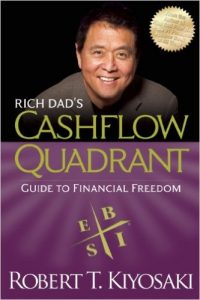 Who is Robert Kiyosaki? (You can read his life advice book and biography here:)
Who is Robert Kiyosaki? (You can read his life advice book and biography here:) However, for starters lets give you a background on just one of his many great books, Rich Dad’s Cashflow Quadrant.
Robert Kiyosaki’s cashflow quadrant system can be summarized in segments:
1) Employee – this is self-explanatory, but it represents anyone that works for an hourly or annual salary for a company. Being an employee is nothing to be ashamed of and many or perhaps most entrepreneurs started as employees. As an employee, one can earn and save money without taking risk
2) Self-employed – Many may hear the concept of self-employed and think this is extremely positive, which can be correct. However, self-employment in Kiyosaki’s sense refers to a person who run’s their own business technically, but must be present at all times managing their business. A great example of this can be a chef that must always be present cooking in order to make a profit.
3) Business Owner – Take that same Chef example, however imagine that Chef is able to teach is cooking recipe to other chefs and pay them a salary, and then slowly grow his one restaurant into several or even hundreds across the country. Kiyosaki defines a business as a profitable venture that manages over 500 employees. His main distinction between self-employed and business owner is the fact that a business owner can simply make income without working. Their business is in place and it continues to make income without the need for the owner to be present with the business. However, someone who is self-employed is their own boss, but they are forced to be present working (like our Chef example)
4) Investor – This may seem self-explanatory as well. Investors gain income simply by lending their money for certain…investments. This can include stock, bonds, real estate, private equity, hedge funds, etc. and can even include directly investing in one’s own business.
Tax Implications
Overall – the reason that Kiyosaki’s book favors business ownership and investment is because current tax regimes make it very difficult to survive as a small business owner as they taxed at higher levels (both as individuals and business owners). Furthermore, the fact that the small businesses require the owner to be present put limits on potential growth, making it difficult for a self-employed person / small business owner to grow past a certain point.
What to Do?
Note that this article is not meant to discourage anyone that is an employee or self-employed, starting and growing a business entails risks and may not be the right move for a person depending on the point they are at in their life. However, it makes sense to educate oneself on the fact that there are other ways to develop income. For instance, say you work as an employee of a company for 25 years and you manage to save $500,000. You are able to invest that money earning between roughly 2-6% in interest. That can earn you at a minimum 10-15 thousand dollars in income per year that you do not need to work at all for, or do anything for, it will come!! Sounds like magic, but it is not. It is investment passive income and it is simply a beautiful thing.
If you’re wondering how exactly you can earn that 2%-6% we mention above…Look no further.
Also look out for a more detailed post on how this may be done!
Please only ask relevant and value adding questions. Thank you!







